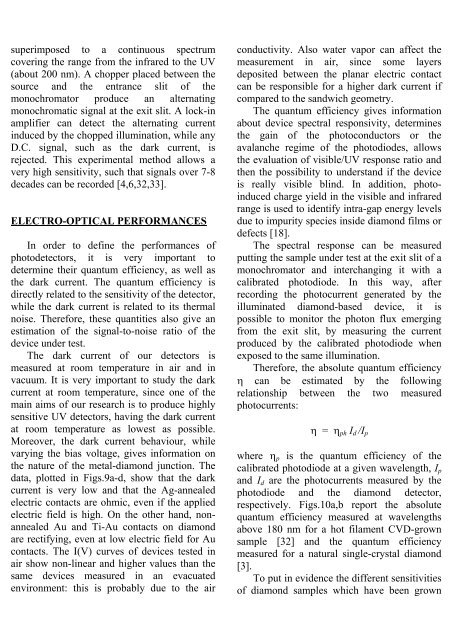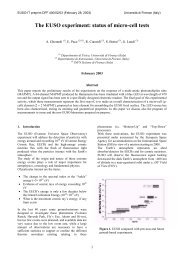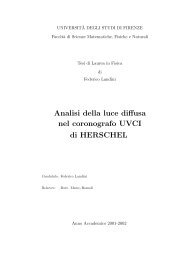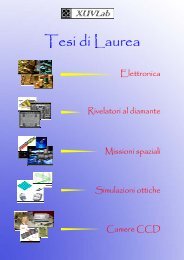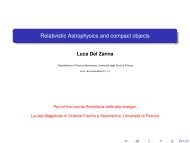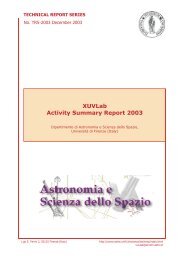Diamond-based UV and soft X-ray photodetectors E. Pace Dip. di ...
Diamond-based UV and soft X-ray photodetectors E. Pace Dip. di ...
Diamond-based UV and soft X-ray photodetectors E. Pace Dip. di ...
You also want an ePaper? Increase the reach of your titles
YUMPU automatically turns print PDFs into web optimized ePapers that Google loves.
superimposed to a continuous spectrumcovering the range from the infrared to the <strong>UV</strong>(about 200 nm). A chopper placed between thesource <strong>and</strong> the entrance slit of themonochromator produce an alternatingmonochromatic signal at the exit slit. A lock-inamplifier can detect the alternating currentinduced by the chopped illumination, while anyD.C. signal, such as the dark current, isrejected. This experimental method allows avery high sensitivity, such that signals over 7-8decades can be recorded [4,6,32,33].ELECTRO-OPTICAL PERFORMANCESIn order to define the performances of<strong>photodetectors</strong>, it is very important todetermine their quantum efficiency, as well asthe dark current. The quantum efficiency is<strong>di</strong>rectly related to the sensitivity of the detector,while the dark current is related to its thermalnoise. Therefore, these quantities also give anestimation of the signal-to-noise ratio of thedevice under test.The dark current of our detectors ismeasured at room temperature in air <strong>and</strong> invacuum. It is very important to study the darkcurrent at room temperature, since one of themain aims of our research is to produce highlysensitive <strong>UV</strong> detectors, having the dark currentat room temperature as lowest as possible.Moreover, the dark current behaviour, whilevarying the bias voltage, gives information onthe nature of the metal-<strong>di</strong>amond junction. Thedata, plotted in Figs.9a-d, show that the darkcurrent is very low <strong>and</strong> that the Ag-annealedelectric contacts are ohmic, even if the appliedelectric field is high. On the other h<strong>and</strong>, nonannealedAu <strong>and</strong> Ti-Au contacts on <strong>di</strong>amondare rectifying, even at low electric field for Aucontacts. The I(V) curves of devices tested inair show non-linear <strong>and</strong> higher values than thesame devices measured in an evacuatedenvironment: this is probably due to the airconductivity. Also water vapor can affect themeasurement in air, since some layersdeposited between the planar electric contactcan be responsible for a higher dark current ifcompared to the s<strong>and</strong>wich geometry.The quantum efficiency gives informationabout device spectral responsivity, determinesthe gain of the photoconductors or theavalanche regime of the photo<strong>di</strong>odes, allowsthe evaluation of visible/<strong>UV</strong> response ratio <strong>and</strong>then the possibility to underst<strong>and</strong> if the deviceis really visible blind. In ad<strong>di</strong>tion, photoinducedcharge yield in the visible <strong>and</strong> infraredrange is used to identify intra-gap energy levelsdue to impurity species inside <strong>di</strong>amond films ordefects [18].The spectral response can be measuredputting the sample under test at the exit slit of amonochromator <strong>and</strong> interchanging it with acalibrated photo<strong>di</strong>ode. In this way, afterrecor<strong>di</strong>ng the photocurrent generated by theilluminated <strong>di</strong>amond-<strong>based</strong> device, it ispossible to monitor the photon flux emergingfrom the exit slit, by measuring the currentproduced by the calibrated photo<strong>di</strong>ode whenexposed to the same illumination.Therefore, the absolute quantum efficiencycan be estimated by the followingηrelationship between the two measuredphotocurrents:η= η ph I d /I pwhere ηp is the quantum efficiency of thecalibrated photo<strong>di</strong>ode at a given wavelength, I p<strong>and</strong> I d are the photocurrents measured by thephoto<strong>di</strong>ode <strong>and</strong> the <strong>di</strong>amond detector,respectively. Figs.10a,b report the absolutequantum efficiency measured at wavelengthsabove 180 nm for a hot filament CVD-grownsample [32] <strong>and</strong> the quantum efficiencymeasured for a natural single-crystal <strong>di</strong>amond[3].To put in evidence the <strong>di</strong>fferent sensitivitiesof <strong>di</strong>amond samples which have been grown


